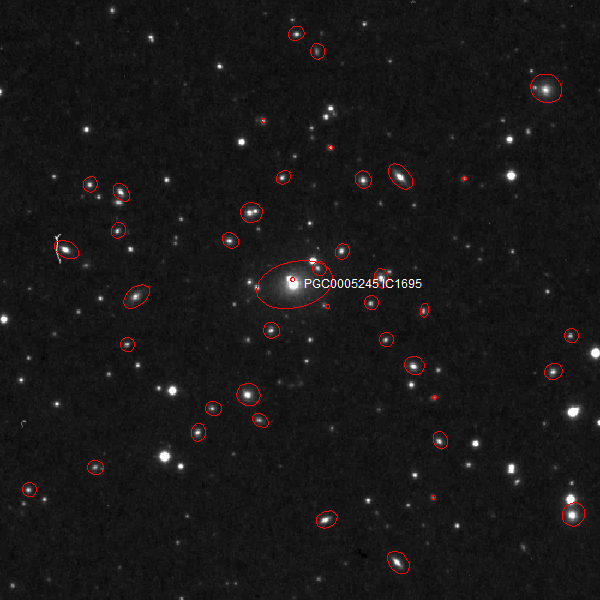Redshift discordancies are often more subtle and appear in much larger groups than the examples I have shown so far. A good example of this occurrence is in the galaxy cluster Abell 0193. The following image was exported from an excellent sky chart program written by Patrick Chevalley called Cartes Du Ciel. I prefer to use version 2.76c although a newer version can also be downloaded here. The photograph is from the European Southern Observatory’s (ESO) first Digitized Sky Survey (DSS-1) overlaid with object outlines generated from the latest Principal Galaxies Catalog (PGC).

This image shows a number of small morphologically similar spiral galaxies surrounding a larger elliptical galaxy (PGC 5245/IC 1695) in a very obvious spiral pattern which I call a “super spiral”. This super spiral structure appears to be comprised of three or more arms and is turned slightly at an angle in relation to the observer.
The image below was also exported from Cartes Du Ciel and was cropped to fit on this page. This time the photograph is from the ESO’s second Digitized Sky Survey (DSS-2) red channel while the object outlines are again generated from the PGC. In this image I have labeled and included the redshifts (z) for all the objects in one of the spiral arms including the center elliptical galaxy.
 At first glance the redshift values do not appear to vary greatly from one another and seem to fall within a narrow range. However, when these values are converted to distances it immediately becomes apparent that there is something very wrong with the measurements. The most distant object among those labeled measures over 1.026 billion light years away when its redshift is converted using a so-called Hubble Constant value of 55 (km/s)/Mpc. The closest object measures over 731 million light years away when performing the same conversion. This represents a maximum separation among all of the objects of over 295 million light years with most of the objects being separated from one another by distances of tens and even hundreds of millions of light years. However, it is highly unlikely that these objects are separated by such vast distances while still being clearly lined up to form one of the many spiral arms of this large galactic cluster. There is simply no known mechanism in the Universe that can account for such a widely dispersed string of galaxies, not even “dark matter” or “dark energy”.
At first glance the redshift values do not appear to vary greatly from one another and seem to fall within a narrow range. However, when these values are converted to distances it immediately becomes apparent that there is something very wrong with the measurements. The most distant object among those labeled measures over 1.026 billion light years away when its redshift is converted using a so-called Hubble Constant value of 55 (km/s)/Mpc. The closest object measures over 731 million light years away when performing the same conversion. This represents a maximum separation among all of the objects of over 295 million light years with most of the objects being separated from one another by distances of tens and even hundreds of millions of light years. However, it is highly unlikely that these objects are separated by such vast distances while still being clearly lined up to form one of the many spiral arms of this large galactic cluster. There is simply no known mechanism in the Universe that can account for such a widely dispersed string of galaxies, not even “dark matter” or “dark energy”.
If this was the only known example of a super spiral formation in the observed Universe it could be argued that perhaps the shape of this cluster is simply coincidental. However there are several examples of Abell clusters that are super spirals and I will be posting these in the future. So if one accepts the fact that these galaxies are indeed bound into spiral shapes the only logical explanation for their discordant redshifts and associated distances is that extragalactic redshifts do not accurately represent distances and an associated expansion of the Universe.
Do you have questions or comments about this example or do you have an example you would like to contribute? Your input is not only welcomed, it is encouraged.
Shannon
Tags: Abell 193, Cartes Du Ciel, Digitized Sky Survey, European Southern Observatory, galactic cluster, George Abell, Principal Galaxies Catalog, Super Spiral
